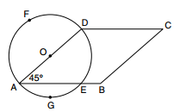
In the rhombus, BC=6, AE=4, and angle DAE = 45°. AD is the diameter of the circle. If a man started at C and followed around the outer edge of this figure to D, F, A, G, E, B and back to C, approximately how far did he travel?
A. 14 + 27/4*Ï€
B. 14 + 6Ï€
C. 12 + 6Ï€
D. 14 + 9/2*Ï€
E. 12 + 9/2*Ï€
The OA is D.
Please, can any expert explain this PS question for me? I tried to solve it but I can't get the correct answer. I need your help. Thanks.



















